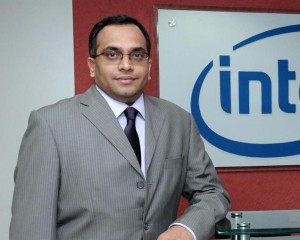Mr. Suryanarayanan B. – Director, Sales – Intel South Asia, spoke to IT Voice exclusively, about the company’s plans related to mobile devices and latest launch from the company.
Shweta: Last few quarter results have led people to sa y that we are living in a post-PC era? Can desktops and notebooks survive in a smart phone and tablet world? What is your take on this?

Mr. Suryanarayanan: While Intel is committed to next-gen mobile devices, we still recognize the fact that the laptops/ desktops are nodal to all computing experiences today. So, be it transferring files from your phone to a larger storage device or a tablet, the desktop plays the part of a central device that can easily keep all your computing devices connected thus giving you them most complete computing experience. We are also cognizant of the fact that the mobile experience is still not comparable to the desktop/notebook – especially when the purpose of usage is creation of software property or hardcore gaming – be it for the enterprise or channel domains or be it for industry verticals like entertainment, healthcare, retail etc. Infotainment and connectivity still remain the dominant drivers for phones/tablets/phablets, but heavyweight work and professional consumption is still completely dependent on notebooks or desktops. Our aim is to bring alive the compelling user experiences that a PC can deliver as a part of the consumer’s personal computing ecosphere, and we are committed to driving this message across the country.
Shweta: Looking at the increasing mobility, Intel recently launched Ultrabook 2 in 1. How has been the response so far for the product?
Mr. Suryanarayanan: Globally, Ultrabooks as a category are growing 50 per cent Y-o-Y, touch designs are growing 3X and 2-in-1 designs are growing at 10X from the spring of 2013 to the holiday season in December 2013.
We at Intel realized the potential both these forms represent and have incorporated them together. Henceforth most Ultrabooks will be touch enabled as they deliver stunning graphics and offer the ultimate in precision and control. With multiple input options in a 2 in 1 device, the consumer is presented with a plethora of choices how he may want to use his device, be it completing office assignments on a high performance Ultrabook, or relaxing by playing games or watching movies on his detachable tablet. The Ultrabooks deliver to the consumer a computing experience like never before. Being such unique and innovative devices, the 2 in 1 Ultrabooks have been positively recieved by the market, with our partner OEMs coming out with exciting new devices by the end of the month.
Shweta: Quite a buzz was created around new Atom tablet chips code-named Bay Trail at Intel Developer Forum. Can you please elaborate on the same?
Mr. Suryanarayanan: Based on a new low-power, high-performance microarchitecture “Silvermont,” (announced in May 2013), “Bay Trail” is Intel’s first tri-gate 3-D 22nm quad core SoC and its most powerful processor to-date for tablets and other sleek devices that provide a balance of performance, features and battery life. The flexibility of the Silvermont microarchitecture allowed Intel to deliver multiple variants of the platform to market for the tablet, 2 in 1, entry laptop and desktop and all-in-one (AIO) segments. “Bay Trail-T” is the next-generation 22nm quad-core Intel® Atom™ SoC for tablets and 2 in 1 devices. The “Bay Trail-M” and “Bay Trail-D” parts are for innovative entry-level laptops, 2 in 1s, desktops and AIOs that will be branded Intel® Pentium® and Intel® Celeron
Intel Atom Processor Z3000 Series
“Bay Trail-T,” now known as the Intel Atom Processor Z3000 Series, is Intel’s most capable, high performance SoC to-date for tablets and other sleek mobile devices and the lowest-power platform of the Bay Trail family.
Shweta: As Intel works with large channel community across extended product portfolio, what’s the key message to partners at large?
Mr. Suryanarayanan: Intel first established the Reseller Channel Organization (RCO) to focus on the needs of our worldwide network of distributors, resellers, Local OEMs (LOEMs) and local integrators. The Intel channel sells products through a network of >850 distributor locations. The channel programs encompass a membership network of over 250,000 partner members in 160 countries. The Intel Technology Provider Program is designed to help channel customers market, sell and support Intel platforms and solutions. The Intel channel components integration business covers ~20 percent of Intel’s CPU billings. In addition, Intel is on a path to engage with MNC-branded resellers through RCO. These resellers, in conjunction with the historic integration customer base, comprise more than 50 percent of Intel’s PC consumption.
Intel aims to support its partners to create, support and sell Intel-based products and solutions beyond the PC to meet the demands of the market; and to develop different business models to suit the evolving market. Our partner’s success is the crucial to Intel’s success and we continue to invest wholeheartedly in supporting the growth and innovations of our partners in this changing marketplace. As the explosion of devices, life online and increasing mobility is forcing change in consumer demands for computing solutions; we recognize that the business models of our channel partners are also evolving. There is an opportunity for the partner ecosystem to deliver seamless and consistent experiences across a continuum of different devices to consumers.
At Intel, we provide our partners with the training, marketing, sales and service support to enable their success. We are taking a business framework approach to meet our channel members’ needs. This framework considers how we map our tools and resources at each step of the execution — including planning, training, marketing and selling, services and measurement — so we can tailor our offerings for a particular partner type and partner focus.






